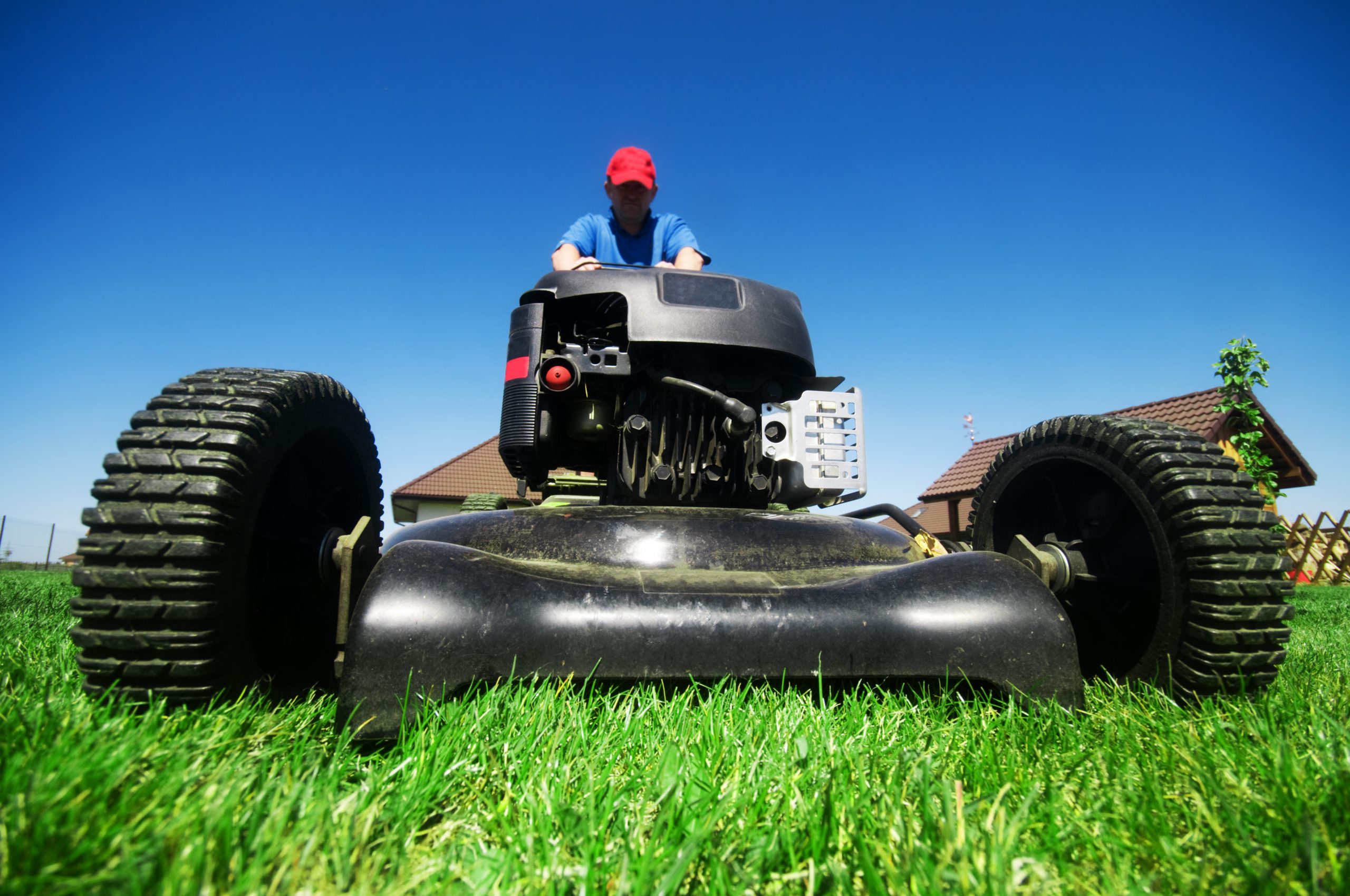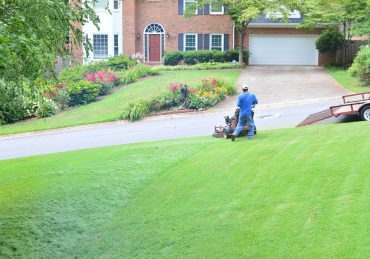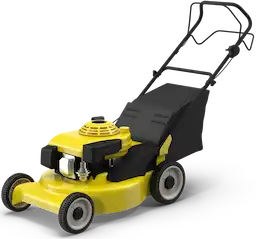You’ve noticed that pesky moss is taking over your lush lawn, turning it into a patchy, green mess. Don’t worry; you’re not alone in this battle. While moss can seem relentless, there’s a systematic way to tackle it and reclaim your lawn’s beauty. By understanding why moss thrives and taking strategic steps to remove it, you can prevent it from returning. Curious about how to achieve this transformation? Let’s investigate effective solutions.
Why Moss Takes Over Your Lawn
Moss can quickly take over your lawn if you don’t address excessive moisture and poor drainage, which create the perfect damp environment for its growth.
Shaded or compacted areas also contribute to moss dominance, as they hinder grass health and allow moss to flourish.
Furthermore, soil acidity, poor fertility, and over-mowing stress your lawn, making it even more vulnerable to moss invasion.
Excessive Moisture and Drainage Problems
When your lawn struggles with excessive moisture, it sets the stage for moss to take over. Poorly drained soils often lead to soggy conditions where moss thrives over grass.
Compacted soil from heavy foot traffic also contributes to drainage issues, reducing grass growth and allowing moss to dominate. To tackle this, consider using a moss killer containing iron sulphate to improve soil conditions.
Furthermore, aeration and scarification can alleviate drainage issues, promoting healthier grass. These steps not only help remove existing moss but also prevent future invasions, ensuring your lawn remains lush and vibrant.
Don’t let excessive moisture win.
Easily hire the best lawn & landscape pros working in your neighborhood.
Shaded or Compacted Areas
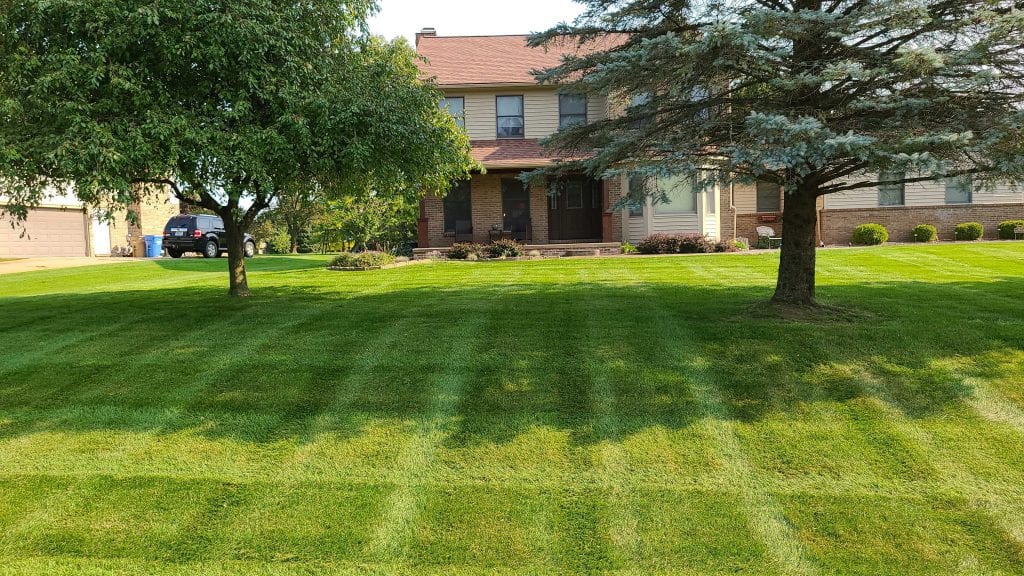
If your lawn has shaded or compacted areas, it creates a perfect environment for moss to flourish.
In shaded spots, grass struggles to grow due to limited sunlight, allowing moss to take over. Compacted soil, often a result of heavy foot traffic, restricts root development and limits drainage. This makes it challenging for grass to thrive and gives moss an advantage.
To prevent moss from dominating your lawn, regularly address these issues. Consider thinning tree canopies to increase sunlight exposure and aerate compacted soil to improve drainage.
These steps encourage healthy grass growth, which competes better against moss.
Soil Acidity and Poor Fertility
Although it might seem like moss appears out of nowhere, it’s often a sign that your lawn’s soil is too acidic or lacking in nutrients. Acidic conditions, with pH levels below 6.0, hinder grass but encourage moss. Poor soil fertility weakens grass, allowing moss to dominate. Regular soil testing reveals these issues, letting you amend soil with lime to balance pH and boost fertility. Implement a nutrient-rich fertilization plan to strengthen your lawn.
| Factor | Solution |
|---|---|
| Acidic Soil | Apply lime |
| Poor Fertility | Use balanced fertilizers |
| Soil Becoming | Regular testing and amendment |
Prioritize soil health to reclaim your lawn.
Over-mowing and Lawn Stress
Frequent short mowing can spell disaster for your lawn, as it weakens the grass by removing too much of the essential leaf area needed for photosynthesis and overall plant health.
Over-mowing makes your lawn vulnerable, welcoming lawn moss to take over. When grass is stressed, it struggles to compete with moss. Here’s why:
- Damp Conditions: Short mowing leads to poor drainage, creating the perfect damp breeding ground for moss.
- Compacted Soil: Over-mowing often results in soil compaction, limiting grass root development.
- Reduced Turf Density: Mowing too short reduces the grass’s density, making it easy for moss to invade.
How to Get Rid of Moss in Your Lawn Safely and Effectively
To effectively remove moss from your lawn, start by raking or scarifying it to physically eliminate the moss.
Once the moss is removed, apply a moss killer, either chemical or natural, to guarantee any remaining spores are dealt with.
Make sure to time your application effectively, usually in early spring or autumn, for the best results.
Rake or Scarify to Remove Moss from Lawn
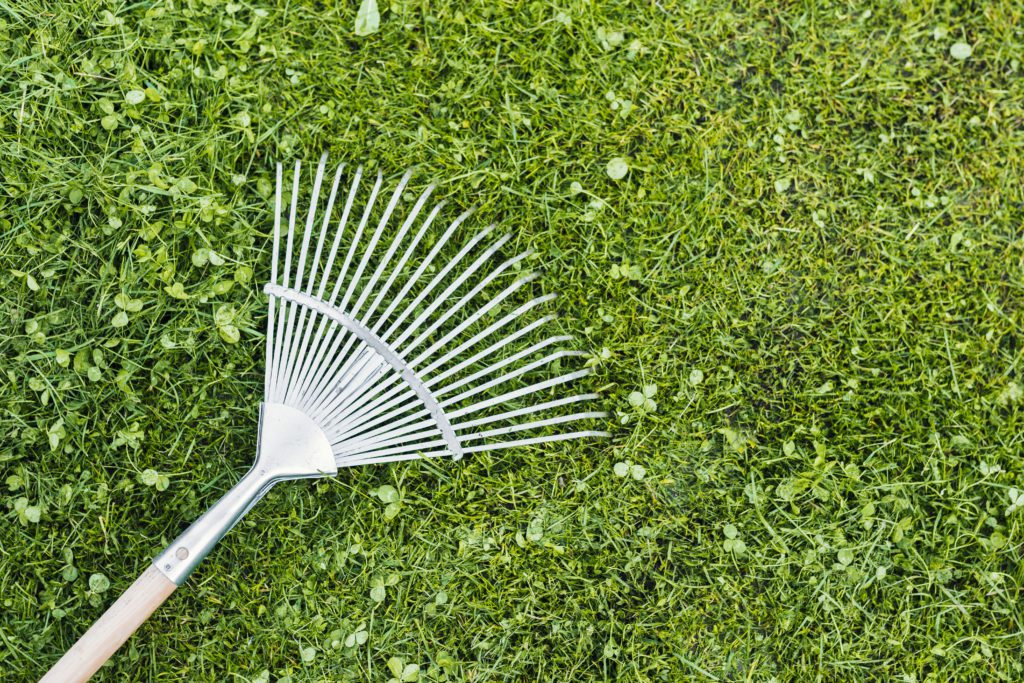
When you’re tackling moss in your lawn, raking or scarifying is a key step in the process.
By scarifying, you effectively remove moss and thatch, improving air circulation and encouraging healthier grass growth.
Follow these steps for success:
- Choose the right time: Scarify in the autumn when your grass is robust and can recover quickly.
- Prepare the lawn: Confirm the soil is slightly moist to make it easier to remove moss without harming the grass.
- Rake thoroughly: After scarifying, rake out the dead moss. Compost it after a few weeks to prevent reintroducing spores.
Your lawn’s transformation is one step away!
Easily hire the best lawn & landscape pros working in your neighborhood.
Apply a Moss Killer (Chemical or Natural)
Although moss can be a persistent nuisance, applying a moss killer is an effective way to tackle it.
To kill moss effectively, you can choose between chemical and natural solutions. For chemical options, a granular moss killer with ferrous sulphate guarantees even coverage. Use a lawn spreader or apply by hand.
If you prefer a natural approach, a diluted dish soap solution works well. Use a watering can or garden sprayer for liquid applications. Make sure no rain for 24 hours after to maximize effectiveness.
Follow product instructions carefully to avoid harming the surrounding grass and other plants where moss is growing.
When and How to Apply Moss Killer Effectively
One of the key steps in managing moss in your lawn is knowing the right time and method to apply moss killer effectively.
To guarantee the best results, follow these strategies:
- Choose Dry Weather: Apply moss killer when no rain is forecasted for 24 hours. It guarantees the product has time to work efficiently.
- Select the Right Product: Use a granular moss killer with a spreader for even coverage, or a diluted liquid option applied with a sprayer.
- Timing Matters: Treat heavy moss in autumn when your grass is strong enough for scarification, promoting healthier regrowth and long-term moss care.
Reclaiming Lawn Health After Moss Removal
After removing moss, focus on reclaiming your lawn’s health by aerating the soil, which improves drainage and deters moss from returning.
Overseed bare patches to boost lawn density and prevent future moss invasions.
Keep an eye on your soil’s pH and nutrients, adjusting with lime and fertilizer as needed to maintain a thriving grass environment.
Why Aerating Your Lawn Helps Keep Moss Away
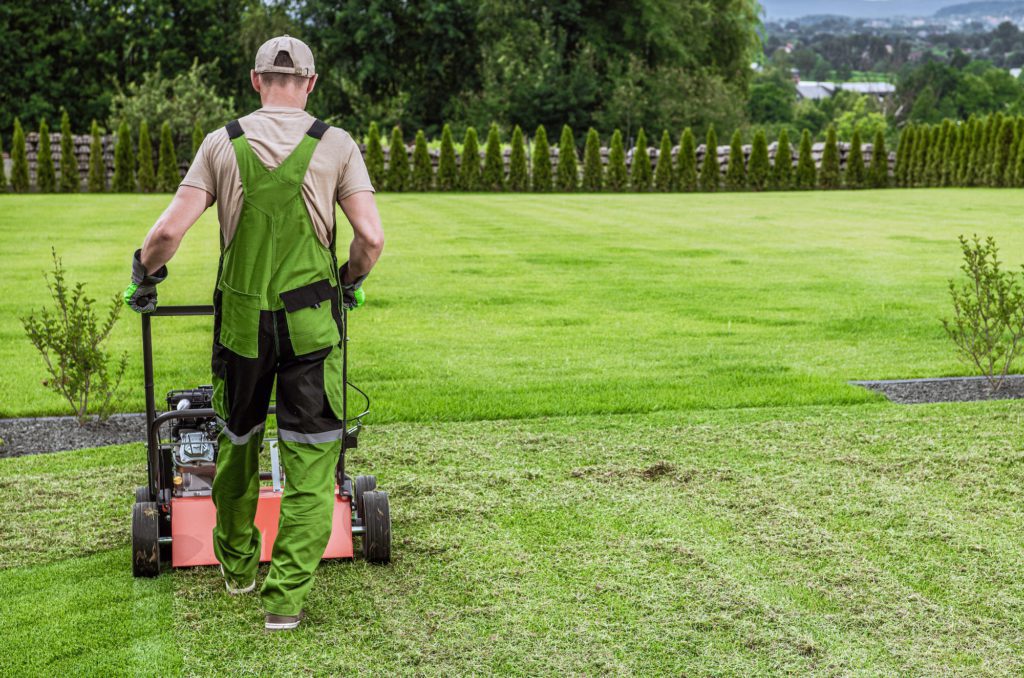
When you want to keep moss from reclaiming your lawn, aerating the soil is a key strategy.
By creating holes in the soil, you relieve compaction, allowing grass to access essential nutrients and develop strong roots. This makes your lawn healthier and better equipped to outcompete moss.
Regular aeration improves drainage, reducing moisture levels that moss loves. It also guarantees that moss killers and fertilizers reach grass roots effectively.
Here’s why you should aerate:
- Boost root development: Strong roots enhance turf density.
- Improve drainage: Less moisture discourages moss growth.
- Enhance nutrient uptake: Healthier grass outcompetes moss.
Overseeding Bare Patches
To restore your lawn’s health after removing moss, overseeding bare patches is an essential step. Choose grass seed varieties that thrive in your climate, providing resilience against future moss. The best time to overseed is early spring or early fall. Lightly rake the soil to improve seed-to-soil contact, ensuring successful establishment. Keep the area well-watered, especially during dry spells, to support healthy growth and reduce moss re-infestation. These steps replenish nutrients and foster robust grass cover.
| Task | Action |
|---|---|
| Seed Selection | Choose climate-appropriate seeds |
| Timing | Early spring or fall |
| Soil Preparation | Lightly rake soil |
| Watering | Maintain moisture |
| Outcome | Dense, healthy grass |
Fix Soil pH and Nutrients
Although dealing with moss can be frustrating, reclaiming your lawn’s health starts with fixing soil pH and nutrient levels.
Begin by testing your soil’s pH. Moss loves acidic environments, so aim for a pH between 6.0 and 7.0.
To achieve this:
- Apply Dolomitic Lime: This raises pH and adds magnesium, promoting healthier grass.
- Fertilize: Use a balanced lawn fertilizer after moss removal to boost grass recovery, ensuring water and nutrients are effectively utilized.
- Incorporate Micronutrients: Regularly adding these enhances your lawn’s resilience against future moss invasions.
Monitor and adjust as needed for ongoing health.
How to Prevent Moss from Growing Back in Your Lawn
To keep moss from returning, focus on improving sunlight penetration and airflow by trimming overgrown trees and shrubs.
Set your mower to a higher setting to avoid cutting more than a third of the grass blade, which helps maintain a strong lawn.
Finally, optimize drainage by aerating the soil regularly, ensuring water doesn’t pool and create a haven for moss.
Improve Sunlight Penetration and Airflow
When tackling moss problems, improving sunlight penetration and airflow is essential for keeping it at bay.
To effectively get rid of moss and maintain a healthy, suggested lawn, consider these strategies:
- Prune Trees and Shrubs: Trim overhanging branches to allow more sunlight to reach your grass. This discourages moss and promotes healthy turf growth.
- Enhance Airflow: Aerate your lawn to improve soil ventilation, which reduces humidity and makes it less hospitable for moss.
- Ensure Proper Drainage: Regular aeration prevents water accumulation, creating an unfavorable environment for moss.
Implementing these steps will help your lawn thrive and keep moss away for good.
Set a Better Mowing Height
If you want to keep moss from making a comeback, setting a better mowing height is crucial.
Take care to maintain your grass at 2.5 to 3.5 inches for cool-season varieties. Cutting only a third of the blade height at each mowing helps the grass stay strong and outcompete moss.
In shaded areas, raise the mowing height slightly, allowing your lawn to absorb more sunlight, reducing moss chances.
Keep mower blades sharp to guarantee clean cuts, minimizing stress on the grass.
Regularly adjust your mowing height with seasonal changes to promote a dense, healthy turf that resists moss invasion.
Optimize Drainage
Although dealing with moss might seem like an uphill battle, optimizing drainage in your lawn is a crucial step to prevent its return.
Start by aerating your lawn to relieve soil compaction, which boosts drainage and reduces moisture retention. Implement proper irrigation practices by watering early in the morning to avoid excess moisture. You can also enhance your soil structure by top-dressing with sand and organic materials.
To guarantee lasting results, consider these actions:
- Monitor lawn conditions regularly for poor drainage.
- Adjust grading or add drainage solutions as needed.
- Prune trees and shrubs to increase sunlight exposure and reduce dampness.
Need Help Controlling Moss in Your Existing Lawn?
Are you ready to finally say goodbye to pesky moss in your lawn for good?
Start by scarifying your lawn to physically remove moss and boost your grass’s health. After scarifying, apply a moss killer containing ferrous sulphate, ideally in autumn when the grass is robust enough to recover.
Make sure to follow product instructions carefully and apply during dry weather for the best results.
Regular lawn maintenance is key, ensure proper aeration and overseed with dense grass varieties.
Consistently monitor for signs of moss and address underlying issues like excessive shade and poor drainage to maintain a healthy lawn environment.

